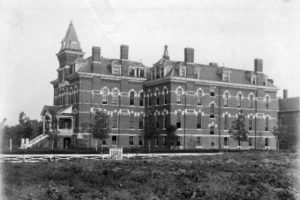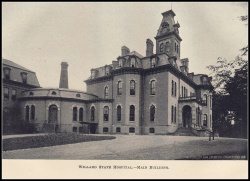Early mental health specialists differentiated between the acute insane–curable–and the chronic insane, for whom they felt little hope. Alienists believed that insanity was curable if it could be caught and treated early, and were eager to get patients into institutions as quickly as possible. The beautiful, elaborate institutions they supervised were specially constructed to jolt someone who had recently become insane from his or her mindset, and restore it to health.
Even though it was seldom cured, chronic insanity was still a problem society needed to address. Alienists argued that it was far cheaper to house the insane in large institutions that were nearly self-sustaining, than to throw them in prisons or poorhouses where there was little opportunity for them to help earn their keep. Additionally, some chronic insane would be cured in an asylum, thus saving society the expense of housing them for a lifetime. Because of these arguments, several states built asylums specifically for their chronic insane.
_______________________________________________________________________
RELATED POST:
Better Treatment for the Insane








